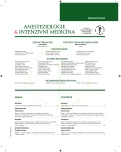Perioperative monitoring of blood glucose levels in paediatric patients
Authors:
J. Žurek 1; M. Vavřina 1; M. Budíková 2
; M. Forbelská 2; V. Bendová 2; M. Richtrová 1; A. Květoňová 1; M. Fedora 1
Authors‘ workplace:
Klinika dětské anesteziologie a resuscitace, Fakultní nemocnice Brno
1; Ústav matematiky a statistiky, Přírodovědecká fakulta, Masarykova univerzita, Brno
2
Published in:
Anest. intenziv. Med., 27, 2016, č. 1, s. 9-14
Category:
Anaesthesiology - Original Paper
Overview
Objective:
The aim was to study perioperative monitoring of blood glucose levels during anaesthesia in paediatric patients.
Design:
Prospective observational study.
Setting:
Department of Anaesthesiology and Intensive Care Medicine, University Hospital.
Materials and methods:
The study included 318 children aged 0–19 years (120 girls, 198 boys) undergoing elective surgery longer than 60 min. The patients were divided into age groups (newborns, infants, toddlers, age 3–6; age 7–12 and age > 12 years). During anaesthesia, blood glucose levels were monitored at the beginning of surgery and then hourly. Hypoglycaemia was defined as value of ≤2.8 mmol/l in neonates, ≤ 3.3 mmol/l in children under 15 and ≤ 3.9 mmol/l in children over 15.
Results:
The lowest and highest measured blood glucose levels were 1.6 mmol/l, and 15.6 mmol/l respectively. 75% of patients had preoperative blood glucose level equal or lower than 5.2 mmol/l. The highest variability in preoperative glycaemia was observed in the category of toddlers and infants and the lowest variability in the category of school age children. Patients who did not have carbohydrate drinks prior to surgery had higher average value of glycaemia (4.61 mmol/l) than patients who did (4.55 mmol/l); p = 0.486. Of the 284 patients who did not have preoperative hypoglycaemia, 250 patients (88%) did not and 34 patients (12%) did have carbohydrate drinks before surgery. Of the 34 patients who had preoperative hypoglycaemia, 27 patients (79.4%) did not and 7 patients (20.6%) did have carbohydrate drinks before surgery.
Conclusion:
Perioperative monitoring of blood glucose represents an essential part of fluid therapy optimization in children during surgical procedures.
Keywords:
glycaemia – hypoglycaemia – children – fluid therapy
Sources
1. Whyte, S. D. Perioperative fluid and electrolyte balance in children. Anaesthesia and Intensive Care Medicine, 2009, 10, p. 93–97.
2. Welborn, L. G., McGill, W. A., Hannallah, R. S., et al. Perioperative blood glucose concentrations in pediatric outpatients. Anesthesiology, 1986, 65, p. 543–547.
3. Berleur, M. P., Dahan, A., Murat, I., et al. Perioperative infusions in paediatric patients: rationale for using Ringer-lactate solution with low dextrose concentration. Journal of Clinical Pharmacy and Therapeutics, 2003, 28, p. 31–40.
4. ASA Task Force on preoperative fasting. Practice guidelines for preoperative fasting and the use of pharmacologic agents to reduce the risk of pulmonary aspiration: application to healthy patients undergoing elective procedures. Anesthesiology, 1999, 90, p. 896–905.
5. Mikawa, K., Maekawa, N., Goto, R., et al. Effects of exogenous intravenous glucose on plasma glucose and lipid homeostasis in anesthetized children. Anesthesiology, 1991, 74, p. 1017–1022.
6. Welborn, L. G., Norden, J. M., Seiden, N., et al. Effect of minimizing preoperative fasting on perioperative blood glucose homeostasis in children. Paediatr Anaesth., 1993, 3, p. 167–171.
7. Larsson, L. E., Nilsson, K., Niklasson, A., et al. Influence of fluid regimens on perioperative blood-glucose concentrations in neonates. Br. J. Anaesth., 1990, 64, p. 419–424.
8. Nishina, K., Mikawa, K., Maekawa, N., et al. Effects of exogenous intravenous glucose on plasma glucose and lipid homeostasis in anesthetized infants. Anesthesiology, 1995, 83, p. 258–263.
9. Geib, I., Dubois, M. C., Gouyet, L., et al. Perioperative perfusion in children: evaluation of a new perfusion solution [in French]. Ann. Fr. Anesth. Reanim., 1993, 12, p. 6–10.
10. Disma, N., Mameli, L., Pistorio, A., et al. A novel balanced isotonic sodium solution vs normal saline during major surgery in children up to 36 months: a multicenter RCT. Paediatr. Anaesth., 2014, 24, p. 980–986.
11. Sümpelmann, R., Mader, T., Dennhardt, N., et al. A novel isotonic balanced electrolyte solution with 1% glucose for intraoperative fluid therapy in neonates: results of a prospective multicentre observational postauthorisation safety study (PASS). Paediatr. Anaesth., 2011, 21, p. 1114–1118.
12. Sümpelmann, R., Mader, T., Eich, C., et al. A novel isotonic-balanced electrolyte solution with 1% glucose for intraoperative fluid therapy in children: results of a prospective multicentre observational post-authorization safety study (PASS). Paediatr. Anaesth., 2010, 20, p. 977–981.
Labels
Anaesthesiology, Resuscitation and Inten Intensive Care MedicineArticle was published in
Anaesthesiology and Intensive Care Medicine

2016 Issue 1
Most read in this issue
- Metabolic consequences of bowel damage in intensive care
- Initial experience with adenosin-induced circulatory arrest during cerebral artery aneurysm surgery – first experience
- Consciousness as a cosmic phenomenon
- Evaluation of Patients With Suspected Acute Pulmonary Embolism: Best Practice Advice From the Clinical Guidelines Committee of the American College of Physicians
